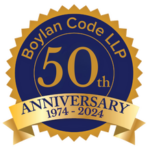I recently had a client come into my office with a foot high stack of documents mailed to him over several months in Kodak’s bankruptcy. For him, the volume rendered a review an all or nothing proposal; unfortunately, he chose the latter, hoping instead that I could make heads or tails of it all. He did offer what has become a familiar observation – “you attorneys sure like killing trees, don’t you?”
While none of the documents in my case proved particularly relevant, tucked amidst this pile of paper could have been an objection to the client’s bankruptcy claim or worse, a complaint seeking the turnover of an alleged preference or fraudulent conveyance. Explaining to a creditor already owed thousands of dollars that he may be required to repay the only money received prior to bankruptcy is hard enough, but articulating how a pleading (or default judgment) could be delivered as causally as a Wegmans’ circular can be worse. Unique to bankruptcy and codified in FRBP 7004(b), plaintiffs are in fact allowed to serve a summons and complaint via first class mail.
While mail service certainly has its pitfalls, courts are continually grappling with how to handle its technological alternatives. In 1980, the Southern District of New York laid the groundwork for service to evolve with technology in a case where the plaintiff was unable to serve defendants located in Iran. Due to the turmoil surrounding the Country at that time, including a breakdown of Iran’s postal system, the District Court allowed alternative service through telex message. Understanding that it had little precedent for its decision, the Court concluded:
Courts…cannot be blind to changes and advances in technology. No longer do we live in a world where communications are conducted solely by mail carried by fast sailing clipper or steam ships. …No longer must process be mailed to a defendant’s door when he can receive complete notice at an electronic terminal inside his very office, even when the door is steel and bolted shut.
New England Merchants Nat’l Bank v. Iran Power Generation and Transmission Co., 495 F. Supp. 73, 81 (S.D.N.Y. 1980).
Like New England Merchants, cases dealing with technological alternatives are grounded in the plaintiff’s initial failure to serve a defendant through traditional means. These plaintiffs must instead turn to CPLR §§ 308(5) and 311(b) in state court, which allow service “in such manner as the court…directs” if “impracticable” by other means. In federal court, FRCP 4(e)(1) allows a plaintiff to utilize the CPLR and the aforementioned alternative methods. In addition, FRCP 4(f)(3) provides a plaintiff the ability to serve an individual in a foreign country through any means directed by court that is not prohibited by international agreement. Due process in either forum requires the method of service be “reasonably calculated” to apprise the defendant of the action.
Under this backdrop, the Western District of New York has now determined that service through email can satisfy a defendant due process rights under Rule 4(f)(3). Cold Spring Construction Co. v. Shandam 2012 U.S. Dist. LEXIS 2357 (W.D.N.Y. 2012). Even more recently, the Fourth Department concluded that service by email on an individual under CPLR 308(5) was “reasonably calculated to apprise defendant of the pending lawsuit and thus satisfied due process.” Safadjou v. Mohammadi, 105 A.D.3d 1423, 1425 (4th Dept. 2013).
In successful cases such as these, the plaintiff established that the email address was reliable and monitored by the defendant. In both Cold Spring and Safadjou, there was evidence the defendant used the address prior to the civil action. In Ryan v. Brunswick Corporation, the defendant’s website actually directed parties to communicate through the fax and email addresses allowed by the Court for service. 2002 U.S. Dist. LEXIS 13837 (W.D.N.Y. 2002). Courts have also looked to whether the defendant contractually agreed to alternative service through an identified facsimile number or email address in a loan application, note or mortgage. See CitiGroup v. Stavros, 2012 NY Slip Op 31546(U) (Sup. Ct. 2013); Community Preservation Co. v. Golden Gate Residence, LLC, 2010 NY Slip Op. 32225(U) (Sup. Ct. 2010).
For many attorneys email has been an accepted means of service for years. Federal Rule 5(b)(2)(E) already allows service of all other papers by “electronic means if the person consents in writing.” That consent for attorneys is typically given through registering to participate in the Court’s Electronic Case Filing System (ECFS). Pursuant to the Western District’s Local Rules (5.1) and Administrative Procedures (§2(f)(i)), once a pleading or paper is filed electronically it is emailed by the court to anyone in the case who is a registered participate with ECFS. This email alone constitutes legitimate services without the need for any additional paper. See also, WDNY Bankruptcy Court Administrative Order 1. The result for any attorney who files a notice of appearance in Kodak’s bankruptcy for example, is an ethical responsibility to review hundreds of docket entries emailed each month to ensure a needle in the form of a claim objection isn’t among the rest of the hay. At least my beleaguered bankruptcy client had the benefit of Kodak printing and mailing all of the documents to him. Unfortunately, due process debates are few and far between when it comes to an attorney who fails to open her ECFS email, as “the Court presumes that registered counsel receives filed documents from the Court…as of the date and time indicated in the Notice of Electronic Filing.” Carovski v. Jordan, 2008 U.S. Dist LEXIS 32138, *11 (W.D.N.Y. 2008). See also, Kolerski v. USA, 2007 U.S. Dist. LEXIS 59142 (W.D.N.Y. 2007) (finding an attorney’s failure to open and review scheduling order emailed via ECFS not a reasonable excuse).
With the parameters of email service initially set, the next technological advancement that courts will likely wrestle with is social media. Earlier this year, the Southern District of New York allowed alternative service through a combination of email and Facebook message. Federal Trade Commission v. PCCare247, Inc., 2013 U.S. Dist. LEXIS 31969 (S.D.N.Y. 2013). This was (to the best of this author’s knowledge) the first published case where a plaintiff was allowed to utilize social media for service. The Court however, cautioned that if it were to allow service only through Facebook “substantial questions would arise whether that service comports with due process.” The general concern being that anyone can create a Facebook account with no assurance that it is actually operated or accessed by the defendant.
It is not difficult to imagine a set of facts that would demonstrate service solely through Facebook reliable enough to afford the defendant due process. If a plaintiff could prove the defendant actively uses the account, couldn’t one find service through Facebook more reasonably calculated to notice the defendant then an indistinguishable document squeezed in a mailbox among coupons and flyers? Acceptance of social media service may eventually evolve as telex, facsimile and email did before it. As the Southern District acknowledged, “history teaches that, as technology advances and modes of communication progress, courts must be open to considering requests to authorize service via technological means of then-recent vintage, rather than dismissing them out of hand as novel.” PCCare247, Inc. at *16-17. Perhaps we will soon see paperless service through Facebook, text message or even Twitter (in 140 characters or less). Regardless, I can tell my over-papered clients that we attorneys are at least trying to lesson our tree killing.
Devin L. Palmer is a Partner at Boylan Code LLP, concentrating his practice on debtor/creditor law, business loan workouts, and commercial bankruptcy. For more information, please contact Devin at (585) 232-5300 or dpalmer@boylancode.com.


